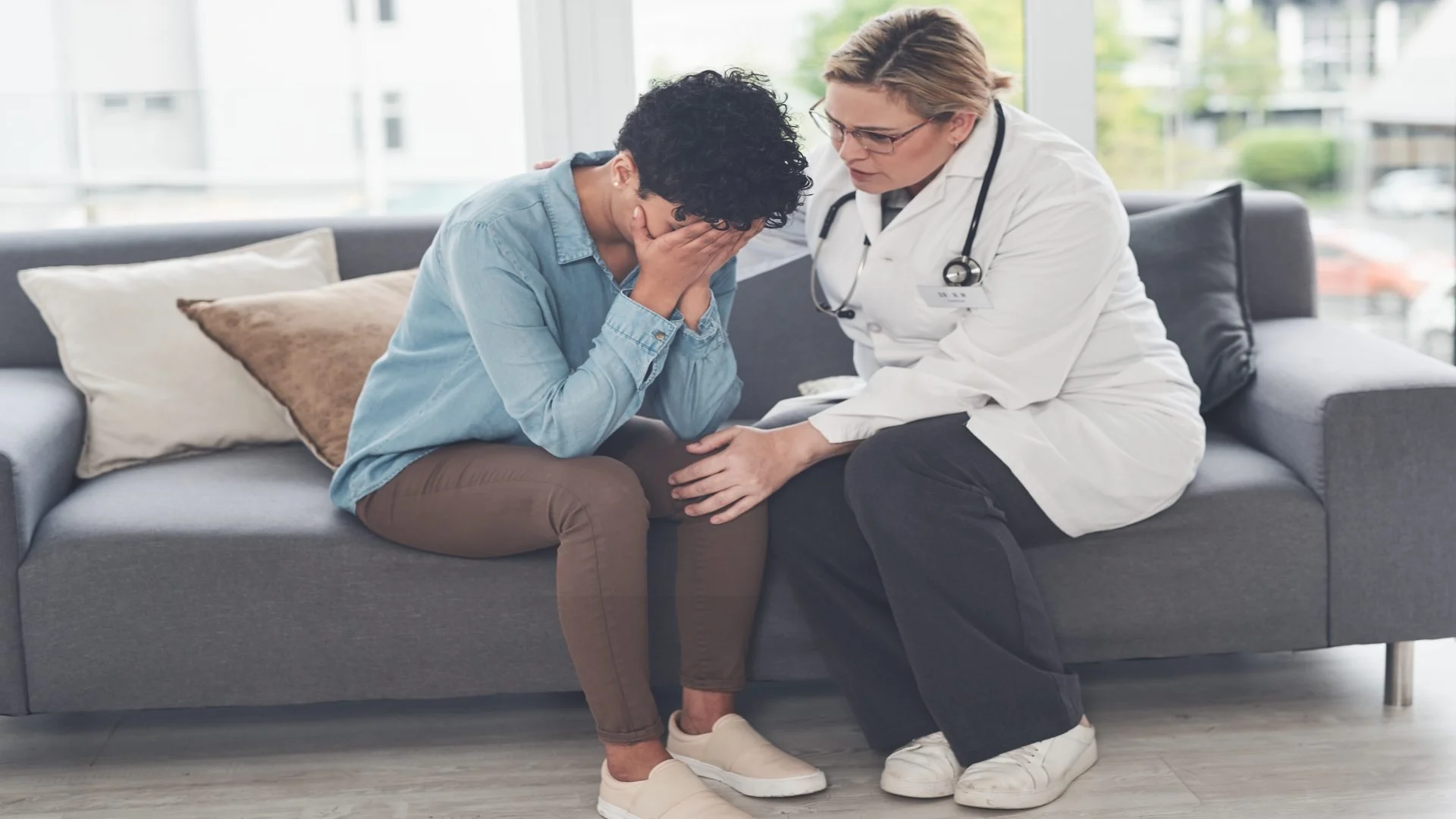Mental Health
Finding Peace

Discover personalized Generalized Anxiety Disorder treatment and find lasting peace with effective, compassionate care tailored to your needs.
What is the primary goal of generalized anxiety disorder treatment?
The primary goal of GAD treatment is to reduce anxiety symptoms and enhance the quality of life. This is achieved by addressing emotional, psychological, and physical aspects through a combination of therapy, medication, and lifestyle changes.
How can personalized treatment improve outcomes for anxiety sufferers?
Personalized treatment tailors care to an individual’s unique needs, preferences, and circumstances. This ensures better engagement, increases treatment effectiveness, and promotes more meaningful progress, ultimately enhancing overall well-being and fostering sustainable anxiety management.
Are there side effects associated with SSRIs for anxiety?
Yes, SSRIs may cause side effects like nausea, insomnia, weight gain, and sexual dysfunction. However, these side effects are usually manageable, and a healthcare provider can adjust the treatment plan to minimize discomfort while maximizing effectiveness.
How does Cognitive Behavioral Therapy help with anxiety?
CBT helps by teaching individuals to identify and challenge negative thought patterns that contribute to anxiety. Through structured sessions, CBT enables individuals to alter behaviors and emotional responses, leading to lasting improvements in managing anxiety.
Can lifestyle changes make a difference in managing anxiety?
Absolutely. Lifestyle changes such as regular physical exercise, a balanced diet, and good sleep hygiene can significantly reduce anxiety symptoms. These changes improve mental health and overall well-being, providing long-term relief and helping individuals manage anxiety more effectively.
Generalized Anxiety Disorder (GAD) can feel overwhelming, whether you're experiencing it yourself or supporting a loved one. It can touch every aspect of life, from professional responsibilities to personal connections. Recognizing that you're not alone is a crucial first step, and seeking personalized support is essential to achieving a lasting recovery.
At The Edge Treatment Center, we recognize that Generalized Anxiety Disorder affects each person differently. That’s why our approach emphasizes individualized care—integrating evidence-based therapies, such as cognitive-behavioral therapy (CBT) and mindfulness practices, and, when appropriate, medication support.
Understanding Generalized Anxiety Disorder (GAD)

Generalized Anxiety Disorder (GAD) is a long-term mental health condition marked by excessive, persistent worry that can interfere with everyday life. Unlike occasional anxiety triggered by specific events, GAD involves chronic worry that often lacks a clear cause.
Individuals with GAD may find it difficult to control their anxiety, even when there is little or no reason to feel anxious. Understanding the nature of Generalized Anxiety Disorder (GAD) is crucial for recognizing its effects and seeking proper support.
Symptoms
GAD symptoms can be both psychological and physical, often affecting multiple areas of life. Common psychological symptoms include constant worrying, restlessness, irritability, and difficulty concentrating.
Physically, individuals may experience muscle tension, fatigue, headaches, and gastrointestinal discomfort, including nausea or an upset stomach. These symptoms can be disruptive, impairing work performance, interfering with social interactions, and diminishing overall quality of life.
Causes and Risk Factors
The exact causes of GAD are not fully understood, but research points to a mix of genetic, psychological, and environmental factors. People with a family history of anxiety or other mental health disorders are at greater risk.
Life experiences such as trauma, ongoing stress, and sudden life changes like the loss of a loved one or job can also trigger or worsen GAD. Additionally, certain personality traits, such as a tendency toward perfectionism or overthinking, may contribute to the development of the disorder.
Impact on Daily Life
Living with GAD can significantly affect day-to-day functioning. Constant anxiety may make it hard to focus on tasks, meet deadlines, or enjoy social and recreational activities. Relationships may suffer due to irritability, avoidance, or emotional withdrawal.
Over time, unmanaged GAD can lead to additional issues, including depression or substance use. Early recognition and professional treatment—through therapy, medication, or lifestyle changes—can help individuals regain control and improve their mental and emotional well-being.
The Importance of Personalized Treatment

Personalized treatment approaches ensure that care is tailored to each individual’s specific needs, leading to more effective symptom management and a more sustainable recovery.
Benefits
Customized plans align with a patient’s lifestyle and preferences, enhancing engagement and reducing anxiety symptoms. By addressing unique triggers and challenges, personalized care promotes a deeper, more meaningful recovery.
Therapy and Medication Integration
A personalized plan often combines cognitive-behavioral therapy (CBT) with medication. This integrated approach targets both psychological and physical aspects of anxiety, improving outcomes while minimizing side effects.
Tailored Support Systems
Support networks—including family, peers, and community resources—reinforce personalized treatment. These systems enhance motivation, provide emotional support, and help maintain consistency in care.

We’re Here To Help You Find Your Way
Would you like more information about mental health or drug addiction? Reach out today.
Cognitive Behavioral Therapy (CBT) for Anxiety
Cognitive Behavioral Therapy (CBT) is one of the most effective, evidence-based treatments for Generalized Anxiety Disorder (GAD).
It focuses on identifying and challenging negative thought patterns that fuel anxiety, helping individuals develop healthier ways of thinking, feeling, and behaving.
CBT provides a practical, skills-based approach that empowers individuals to take control of their anxiety and improve their quality of life.
Core Principles of CBT
CBT is grounded in the principle that our thoughts, emotions, and behaviors are interconnected.
Unhelpful or distorted thinking patterns can intensify feelings of fear, worry, and anxiety, which in turn can influence behavior in negative ways, such as avoidance or withdrawal.
By learning to recognize and reframe these thought patterns, individuals can break the cycle of anxiety and respond to challenges more effectively.
Key Techniques Used in CBT
Several techniques make CBT especially effective for treating anxiety:
Cognitive Restructuring: This technique involves identifying irrational or exaggerated thoughts and replacing them with more balanced and realistic alternatives. By doing so, individuals reduce anxiety by altering how they interpret situations and manage stress.
Exposure Therapy: Gradual and controlled exposure to anxiety-provoking situations helps individuals confront their fears instead of avoiding them. Over time, this reduces sensitivity to triggers and builds tolerance and confidence in managing anxiety.
Other common CBT strategies include relaxation training, mindfulness integration, journaling, and behavioral activation, all of which help reinforce positive mental habits.
Benefits of CBT for Anxiety
CBT offers a structured and goal-oriented treatment format, often leading to noticeable improvement in a relatively short period. It’s collaborative, allowing individuals to actively participate in their recovery and develop problem-solving and coping skills they can use for life.
CBT not only reduces current symptoms but also equips individuals with the tools to prevent relapse and handle future stressors more effectively. With its focus on lasting change, CBT is a powerful resource for those seeking long-term relief from anxiety.
Mindfulness and Relaxation Techniques
Mindfulness and relaxation strategies help calm the mind and body, reducing anxiety symptoms when practiced regularly. When practiced regularly, they help relax both the mind and body, relieving symptoms and promoting emotional balance.
These techniques are especially effective when integrated with other forms of treatment, such as therapy or medication, offering individuals practical tools they can use in everyday life.
Meditation
Guided meditation uses narration and visualization.
Unguided meditation focuses on breath and presence.
Transcendental meditation involves repeating a mantra to achieve deep relaxation and mental clarity.
Breathing Exercises
Intentional breathing helps regulate the nervous system and manage anxiety-related physical symptoms.
Techniques like diaphragmatic breathing and the 4-7-8 method promote calm by slowing the breath and reducing tension.
The Buteyko Method emphasizes nasal breathing, breath control, and reduced breathing volume to restore optimal CO₂ levels in the body, which may help alleviate symptoms of overbreathing and promote overall calmness and focus. This method can be beneficial for individuals with anxiety who experience frequent breathlessness or hyperventilation.
Progressive Muscle Relaxation (PMR)
PMR systematically tenses and then releases muscle groups throughout the body, helping individuals become more aware of physical tension and learn how to release it. Over time, PMR can reduce baseline stress levels and promote a sense of physical ease.
Mindful Movement
Practices such as yoga and tai chi combine gentle physical activity with focused attention. These forms of movement encourage body awareness, improve breath control, and foster emotional stability, making them ideal companions in a holistic approach to anxiety management.

We’ll Lead You to New Heights
Do you have more questions about mental health or drug addiction? Reach out.
Medication Options
Medication can be a key component of GAD treatment. Options vary in mechanism, benefits, and side effects.
Selective Serotonin Reuptake Inhibitors (SSRIs)
Common SSRIs: Fluoxetine (Prozac), Sertraline (Zoloft), Escitalopram (Lexapro)
Benefits: Improve mood, reduce anxiety
Side Effects: Nausea, insomnia, sexual dysfunction, weight gain
SSRIs are often first-line treatments due to their effectiveness and manageable side effects.
Benzodiazepines
Examples: Diazepam (Valium), Alprazolam (Xanax), Lorazepam (Ativan)
Use: Short-term relief of severe anxiety.
Risks: Dependency, withdrawal symptoms—should be used with caution
Beta-Blockers
Examples: Propranolol (Inderal), Atenolol (Tenormin)
Use: Control physical symptoms like a rapid heartbeat.
Note: Best for situational anxiety; not a primary treatment for GAD
The Role of Lifestyle Changes
Lifestyle changes support long-term management of anxiety and improve overall well-being.
Dietary Adjustments
Stay hydrated and eat nutrient-rich meals
Limit caffeine and alcohol to avoid exacerbating anxiety.
Proper nutrition supports the function of neurotransmitters and regulates mood.
Regular Exercise
Exercise boosts endorphins and reduces the levels of stress hormones. Activities like walking, cycling, and yoga can elevate mood and reduce anxiety symptoms.
Sleep Hygiene
Maintain a consistent sleep schedule.
Create an optimal sleep environment (quiet, dark, calm) A good night's sleep improves mood, concentration, and resilience against anxiety.

We’re Here To Help You Find Your Way
Do you need advice about mental health or drug addiction? Reach out today.
The Edge Treatment Center: Your Partner in Recovery
At The Edge Treatment Center, we specialize in addressing mental health and addiction with compassion and personalized care.
Personalized Treatment Plans
Each recovery journey is unique. We provide:
Holistic plans addressing mind, body, and spirit
Evidence-based methods and flexible therapy options
Customized care aligned with individual needs
Compassionate Care
Our experienced team of therapists, counselors, and medical professionals provides empathetic and comprehensive support. We cultivate a respectful, trusting environment where healing can flourish.
Struggling with Generalized Anxiety Disorder? We Can Help
Living with Generalized Anxiety Disorder (GAD) can be overwhelming, but you don’t have to go through it alone. At The Edge Treatment Center, we provide personalized, evidence-based treatment plans tailored to your unique needs.
Our compassionate team supports you every step of the way, helping you manage symptoms and reclaim a sense of calm and control. Whether you're dealing with persistent worry, physical symptoms, or related mental health challenges, we're ready to guide you toward lasting relief. Take the first step toward healing—contact us today and begin your journey to peace.

We’re Here To Help You Find Your Way
If you or a loved one is struggling with addiction, there is hope. Our team can guide you on your journey to recovery. Call us today.
Written by
The Edge Treatment Center
Reviewed by
 Jeremy Arzt
Jeremy ArztChief Clinical Officer
Mental Health
July 17, 2025
